Jewellery and Metal Design
Students here know how to justify their Department’s place. Too easily seen by some as mere adornment, that facile view fails to consider what these students take on board…jewellery can be worn when textiles are not, often occupying a far from trivial, enduring, intimate and symbolic connection with the wearer or holder. There is no common theme here (nor is one assumed), but there is perhaps a bond, exploring deeper matters: the environment, mental health and identity. These objects form both bridge and barrier.
Life cycles, decomposition and kinetic natural world patterning is explored in Isla Easton’s work, making textured and stratified use of unit construction. The full impact of many of these pieces is dependent on the wearer’s movement, taking that human/environmental relationship close indeed. Over-use of plastic bags concerns Naidene Dorman, whose work draws on both contemporary and medieval research. Her armoured mesh constructions are sculptural, and deceptive in their lightness, being of spot-welded steel. Similar preoccupations are explored very differently by Shirley Warnock-Lowe, now an Incorporation of Goldsmiths’ Ambassador for Ethical Making. All her materials are recycled and/or reclaimed. In various scales, both wearable and not, her work in fused glass particularly intrigues. Disappearing bees provide centring concerns for Rebecca Gee, whose graphic statements, using laser-cut unit construction in many materials, are sharply wrought. Zoe Hutchison’s work worries about the environment and our despoiling of the littoral. Weaving in found objects, she finds horror in beauty. Somehow, in her work’s delicate netting, there is something of the dreamcatcher. Stunning pieces indeed. Ailsa Irvine investigates the Seven Deadly Sins, pertinently homing in on Gluttony’s wide-reaching current relevance. There’s a suitably Gothic aspect to her facial casts, skin-painting and oxidised metals. Jewellers have long used dental wax for cire perdue, but rarely quite so aptly!
Iona Anderson’s “journeys” track personal growth and development through balancing acts of miniature cast figures, posed on oxidised forged wires. Human precariousness is evocatively caught. Mental health also provides a starting point for Kim Tiong’s work, which finds ways to connect, dealing with fidgeting and anxiety through jewellery’s sensory portal. Employing laser cutting, unit construction and photo transfer techniques, these tiny playful worlds recall Jean Arp.
There’s an airiness to Claire Mclean’s architectural structures. Her urge to look up translates the British Museum’s vast ceilings into small, highly-wearable metalworks using meshes and unit constructions. Ieva Jankovska looks high too, considering birds’ migratory patterns, enamelling on 3D-printed surfaces already based on muscle tension. Fascinating blue-sky worlds.
Jane Bullivant’s love of her rural environment, rich with flora, fauna and legend is clear. She makes considered use of marbling, cast bronze and unprocessed timber to create medals and small, fun sculptural pieces. Water goddesses, particularly the River Clyde’s Clota, have lent both fluidity and sharpness to Erin Dyer’s work. Her laser-printed miniature statements and oxidised silver rings say much about Celtic deities’ hinging, spinning and disappearing acts.
Outwardly, Naomi Elaine Smith appears the most traditional exhibitor, inspired by Art Deco jewellery, but her study of birds, coupled with her distinctive stone-setting, is very much her own, offering inspired, not derivative work. Unusually perhaps there is just one silversmith. Eve Hendry-Cockburn employs the ancient ways of hand-raising and forging but focuses predominantly on contemporary processes like 3D printing to give her trompe-l’oeil work a contemporary dynamic.
Emma Russell’s jewellery is designed for the runway’s flamboyance; her laser-cut take on jellyfish is boldly glorious, fittingly larger than life sculptural, whilst retaining the creature’s inherent delicacy. Mexican-Scot Andrea Gardiner digs deep into her dual nationality, using curved and open-worked sheet metal and leather. Curvaceous, sculptural manipulations of flat surfaces in very contrasting but sympathetic materials. Taking jewellery right to the skin and beyond, drag artist Liam Clarke explores the spectrums of gender and alternative personae, using make-up’s rich palette, from application to removal. Work opulent in materials, colours and questions.
That seems a fitting note for the whole show.

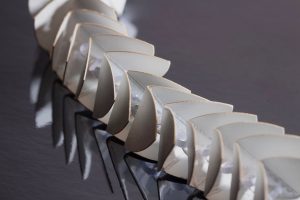
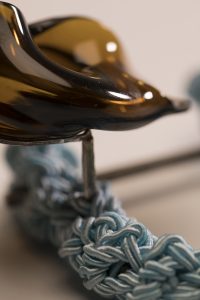
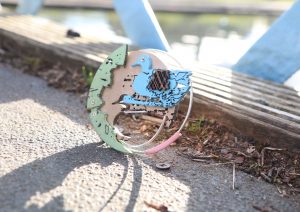
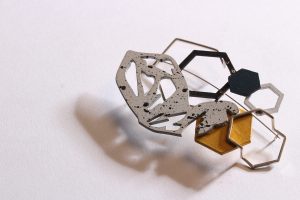
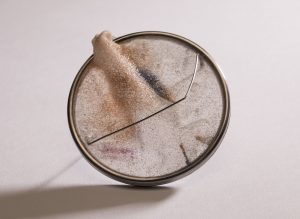
Dying to check this out now, Beth.